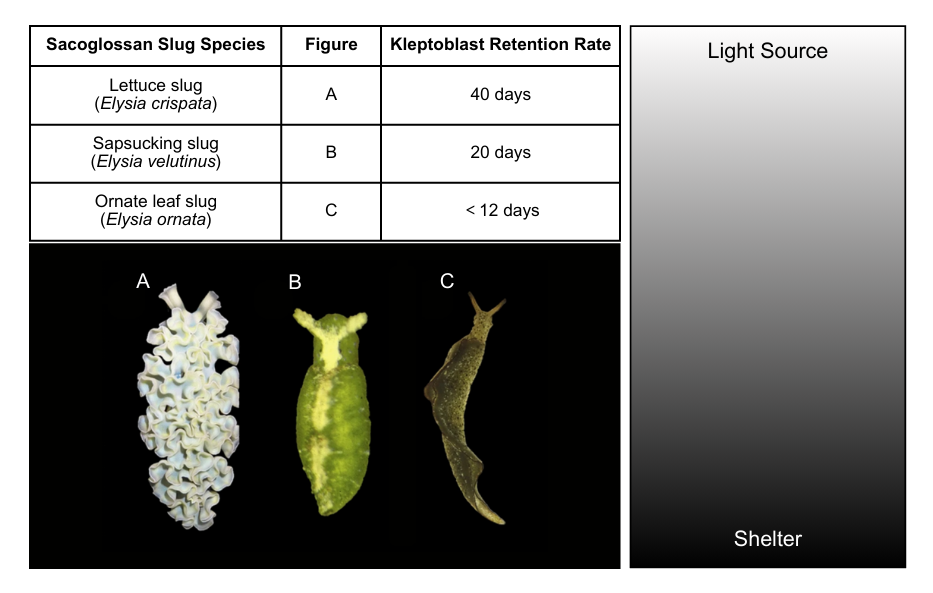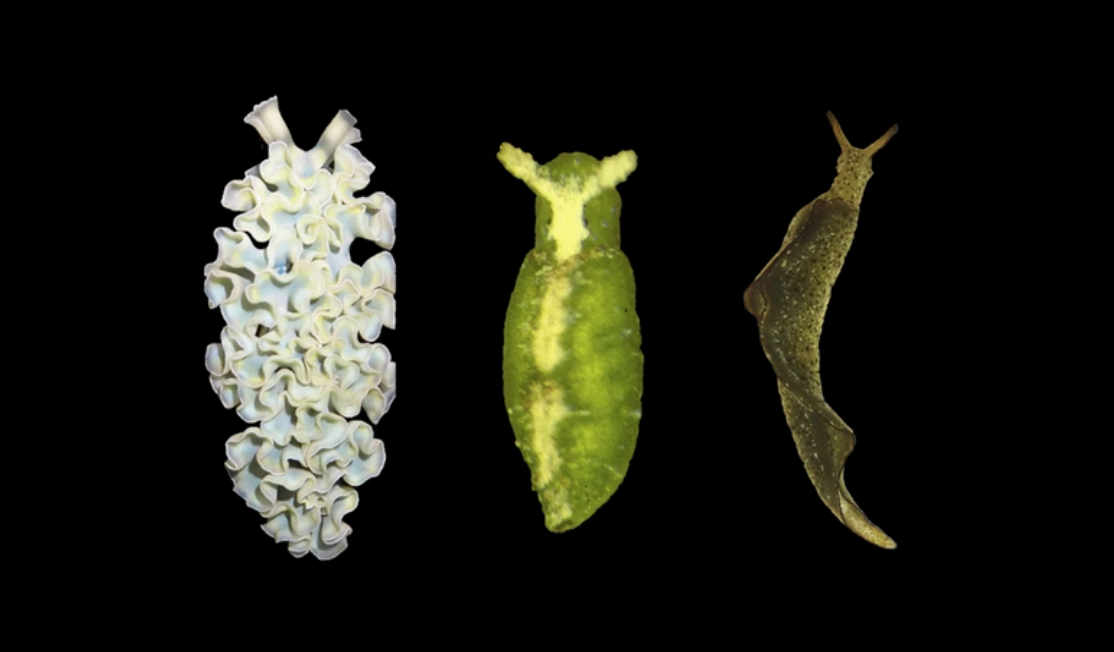Burgués Palau, L., Senna, G. & Laetz, E.M.J. Crawl away from the light! Assessing behavioral and physiological photoprotective mechanisms in tropical solar-powered sea slugs exposed to natural light intensities. Mar Biol 171, 50 (2024). https://doi.org/10.1007/s00227-023-04350-w
You Are What You Eat
What if we could photosynthesize just like plants? Sacoglossan slugs can do just that. They are a group of sea slugs that live along tropical coastlines around the world and feed on algae. As the slugs digest the algae, some species have evolved the ability to retain the chloroplasts and co-op their photosynthetic properties in a process known as functional kleptoplasty. These kleptoblasts can remain functional anywhere from a few days up to several months, supplementing the slug’s diet during food scarcity. However, too much light can cause damage to cells and DNA without proper protective mechanisms in a process known as oxidative stress. The slugs do not inherit these protections (photoprotection) from the kleptoblasts and must employ other methods to protect themselves from permanent injury.
Setting Things Right
Prior studies have investigated this relationship, but have underestimated the amount of natural light exposure in the wild. This is due to the complexity of the interaction between water and light. Numerous factors such as clouds, plants and water clarity affect how much light sea slugs can receive making replication difficult in the lab. This study from Burgués Palau, Senna, and Laetz (2023) corrects this error and found light exposure far exceeds what is needed for optimal photosynthesis in these animals. Therefore, they investigated the photoprotective methods sea slugs employ under these conditions.
Three sacoglossan slug species were studied with different kleptoblast retention rates. Each individual was placed into a tank with a light source on one side and a sheltered, dark spot on the other. The slugs were then tracked for 30 minutes to assess their behavior in direct light and identify photoprotective behaviors. Biopsies were also taken after light exposure to assess oxidative stress on the cells of each species.

Lettuce Slug
The lettuce slug had no preference for light intensity in the tank experiment. This may be because of its photoprotective method which features its parapodia. Parapodia are a muscular extension of a slug’s foot which can be manipulated by individuals for a variety of tasks such as swimming. In this case, lettuce slugs used theirs to cover their kleptoblasts in high light intensities. This resulted in 50% less light reaching their kleptoblasts, mitigating oxidative stress.

Sapsucking Slug
Sapsucking slugs significantly preferred darker areas in the tank. This behavior is seen in the wild with individuals hiding in their food which can form dense clumps that limit light exposure. Biopsies revealed less oxidative stress than expected after light exposure. Some unknown photoprotective method beyond sheltering may be employed that requires further study.
Ornate Leaf Slug
Ornate leaf slugs demonstrated the strongest preference for low light intensities with 66% of individuals preferring the shelter in the tank. However, most individuals found in the wild stay at the top of their algal food, completely exposed. Wave action also reduces the ability for their food to provide shelter like the sapsucking slug. Therefore, the sheltering observed was more than likely an anti-predator behavior due to the tank environment. Their photoprotective behavior could simply be digesting their kleptoblasts within a few days of ingestion, reducing the likelihood of oxidative stress.
Slug Sendoff
All three species were found to be exposed to light intensities beyond their optimal photosynthetic capabilities in the wild. In other words, they would receive more light than necessary to photosynthesize. This can lead to oxidative stress that can harm the sea slugs’ cells and DNA. Each demonstrated a perceived photoprotective behavior to reduce injury:
- Lettuce slug
- Sapsucking slug
- Ornate leaf
- Digest kleptoblasts within a few days
However, more research is needed to understand lingering questions regarding the latter two species.
- Why do sapsucking slugs display less oxidative stress than the other two species?
- What other photoprotection methods do ornate leaf slugs employ to maintain long light exposure behaviors?
This study highlights the importance of testing prior conclusions to ensure sound science. As technology and testing methods improve, we shouldn’t be afraid to question and test what we think we know about this world.
I am a recent MSc graduate in marine biology from Bangor University, where I studied population dynamics of elasmobranchs off the coast of Wales. My interests lie in ecological data analysis to understand environmental processes and identify natural patterns. However, nothing beats being in the field and interacting directly with the marine life.

